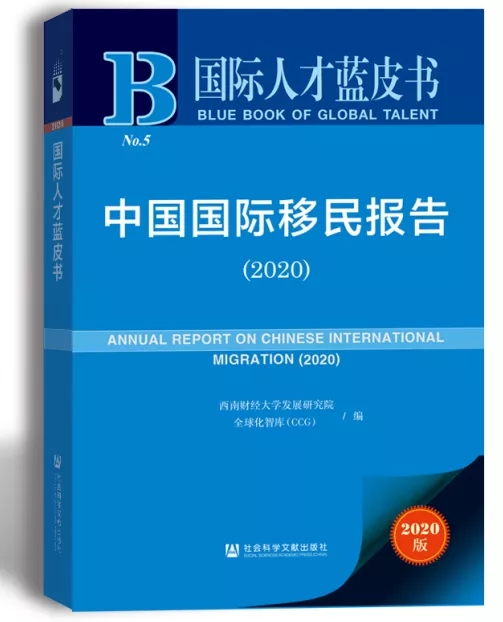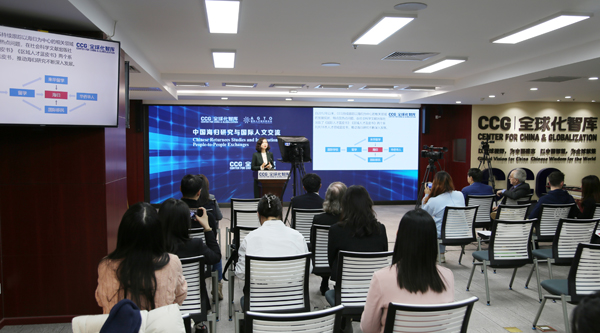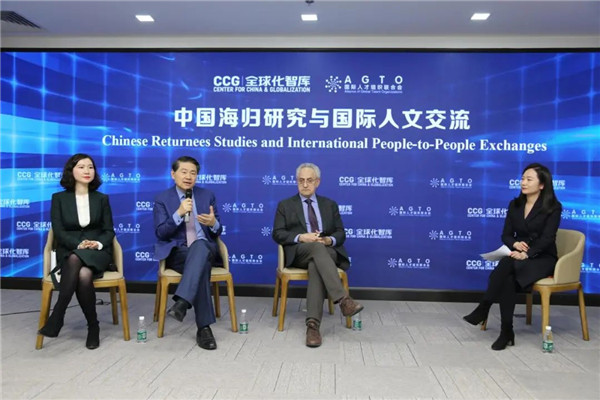CCG’s Annual Report on Chinese International Migration (2020)
December 22 , 2020
Recently, the Annual Report on Chinese International Migration (2020) (hereinafter referred to as the Report) was released at the Fifth International Research Summit Forum. The Report was jointly compiled by Center for China and Globalization (CCG) and the Institute of Development Studies, SWUFE, and published by the Social Sciences Academic Press (China). Cai Jihui, deputy editor-in-chief of the Social Sciences Academic Press (China) participated in the forum and delivered a speech. From a multicultural perspective, the Report analyzes the status quo and trends of international migration as well as the migration policies of major destinations. The Report also provides prospection of international migration development in the post-pandemic era.
The Report states that pending 2019, international migrants were estimated to be almost 272 million globally, accounting for 3.5% of the global population. Regionally, Europe and Asia were the destinations for more than half of international migrants, accepting 82.3 million (30.14%) and 83.56 million (30.86%) respectively. The figure for North America was 58.65 million (22%). Asian international migration saw significant growth. 74% of all international migrants were of working age, while the proportion of immigrants under 20 declined slightly. Approximately 176 million (2/3) international immigrants live in high-income countries.
■ Overall growth rate of international immigration slows down while inter-regional migration increases
According to the study by CCG and the SWUFE research group, the development of international migration revealed new features. First of all, the overall growth of international immigration slowed down, while inter-regional migration increased. In 2019, the growth rate of international migration further dropped to 2005 levels or 9.15%. The number of immigrants who obtained permanent residency declined significantly in many OECD members, such as the U.S., Germany, the UK and so on. However, Inter-regional migration increased – the total amount of immigration within all regions is around 143 million, accounting for 52.6% of total global migration. Compared with 2015, this percentage increased 12.3%, which is higher than the overall growth rate of international migration.
Second, labor migration continued to grow and reflected strong geographical concentrations trend. According to the assessment of the International Labor Organization, there were approximately 164 million migrant workers over the world in 2017, taking up 64% of international migration stock. Labor migration to OECD countries continue toincrease with a year-on-year increase of 6% in 2017. About 111 million migrant workers flowed into high-income countries, taking up to 67.9% of the total, but still decreasing 6.8%. This was related to the continuous tightening of migration policies in some high-income countries represented by the U.S. and the UK. The labor shortages caused by labor migration were economically compensated by remittances.
Third, family migration was still the major channel for permanent migration but the scale shrank slightly. In 2017, there were about 2 million family migrants and accompanying family migrants flowed into OECD countries, accounting for 41%. Subsequent factors included free flow (28%), humanitarian (14%) and labor (11%). With the tightening of immigrant policies adopted by major countries, immigrant approval procedures for family reunification became stricter which caused a slightly shrinking of immigration. In 2017, the number of U.S. migrant families dropped 6%. The figures for New Zealand, Ireland, Norway and the ROK are 22%, 20%, 7% and 5% respectively. Compared with migrant workers, family migrants contributed less to society, which mainly reflected the relatively low employment rate and market wages.
Fourth, international migration management system progressed, but regional coordination mechanisms still need improvement. The Global Compact for Migration elped all countries to develop effective migration response mechanisms and better ways for coordination. Regional agreements such as the East African Common Market Protocol promoted labor free flow and economic development between regions. The rise of the European far right led to many countries’ withdrawal from the East African Common Market Protocol and the reduction in number of recipients of IOM’s AVRR project (a 12% year-on-year decrease in 2018).
Trends in the migration policies of major destination countries include the following. First of all, the war for talent headed up considerably and talent-introduction policy reform escalated. Japan for example set up Japan’s Highly Skilled Foreign Professional Visa and further expanded talent sourcing by establishing a high-level point system. Japan lowered the threshold for highly skilled foreign professionals by adjusting the point standard and adding new award items, easing its visa issuance and speeding up its permanent residency process (3 years for talents with 70 or more points, 1 year for talents with 80 or more points) to achieve its goal put forward in the Investments for the Future Strategy 2017 in advance– attracting 20,000 high-quality professionals before the end of 2022. The UK removed the annual issuance cap for talent visas and abolished the requirement that talent-visa applicants must outline their plans after graduation before arriving the UK. New visa types have also been introduced, such as global talent visas, business-start-up visas and innovator visas. Holders of the global talent visa can apply for permanent residency in 3-5 years. The new visas require a higher English capability, which reflects the UK’s expectation for arrivals to better integrate into local culture.
The majority of EU countries amended their laws between 2018-2019, relaxing the requirements for non-EU researchers and students to move within the EU. Spain and Portugal simplified the procedures for non-EU students to apply for temporary resident permits and working visas. Countries like Sweden relaxed restriction on residence permits for researchers and higher-education professionals. Spain, Italy, Denmark, France and other countries supported foreign entrepreneurs by offering visas and incubator services. The U.S. increased the quota for professional immigrants, increasing the proportion of high skilled immigrants from 12% to 57%. The U.S. also set up an immigrant-point system based on age, education, skill level and other indicators. Points are assessed and green cards are issued based on the merit of the individual. The Fairness for High Skilled Immigrants Act 2019 is another channel for attracting talent.
Second, many countries have expanded labor force inflows and the trend toward targeted migration has become more obvious. Third, immigration restrictions have become stricter and the prospect of international governance is becoming harder to predict. Fourth, the EU Settlement Scheme of the UK remained controversial.
■ China ranks third in migration origin; significant increase in migration stock to Europe
According to the Annual Report on Chinese International Migration (2020), jointly compiled by the Center for China & Globalization (CCG) and the Institute of Development Studies, SWUFE, and published by the Social Sciences Academic Press (China), Chinese international migration featured prominently in six areas.
First, China ranked third among migration origin countries and the stock of migration to Europe increased significantly. According to the report on the global stock of international migration released by the United Nations Department of Social Affairs in 2019, there were 10.7323 million Chinese citizens living abroad, which made China the largest third country of international migrants in terms of origin. As the main source area, Asia saw significant slowing in growth, dropping from 7.36% over the period 2010-2015 to 0.16% over the period 2015-2019. At the same time, as a traditional destination for migration, North America also showed a considerable decrease, falling from 30.95% to 8.09%.
Second, the U.S. and Japan were still major destinations for immigration, while immigrant stock to Singapore declined significantly. In terms of distribution, with the exception of the 2.27 million and 297,600 migrants from China Mainland to China Hong Kong and China Macau, the top twenty destination countries for Chinese migrants did not change significantly. The U.S. was the top one destination, with 2.8892 million migrants, followed by Japan with 784,800 and Canada with 691,500. A review of the top twenty destination countries revealed that 13 of them were developed countries and seven were developing countries. The proportion of developed countries was slightly higher than developing countries. The top twenty destination countries for China mainland migrants in 2015 and 2019 are detailed below.
Third, studying abroad remained popular and migrants have gotten younger and younger. According to the U.S. Open Doors Report in 2019, between 2018-2019, the number of Chinese students coming to the U.S. reached 369,548, accounting for 33.7% of all international students. This ensured China remained the largest source country of international students in the U.S. According to International Facts and Figures 2019, students from China Mainland to the UK reached 106,000, making up 23.2% of all international students in the UK and increasing 12%. China also remained the largest source country of international students in the UK. The number of youth international students grew gradually and this trend is becoming more and more noticeable. Over the decades, the number of Chinese students entering U.S. high schools increased 98.6 times, which is 14 times larger than undergraduates.
Fourth, immediate family members have become the mainstay of Chinese migrants to the U.S., while business migrants declined significantly. In terms of the EB-5 visa, China has always been the main source country for this visa, but the proportion of this visa type has dropped continuously. According to U.S. Annual Report of the Visa Office, in 2019, 3,894 Chinese citizens were issued the EB-5 visa, reflecting a drop over five consecutive years. Compared with other similar U.S. visas, the proportion of EB-5 shrank further with percentages falling from 86.81% in 2015 to 49.36% in 2019.
Fifth, the Common Reporting Standard (CRS) may have influenced the flow of high-net-worth immigration. With the advocacy of the CRS, high-net-worth immigrants have been allocating their resources and choosing their destination countries more cautiously. Low-taxation and non-CRS countries have received more and more attention and become an important choice for high-net-worth immigrants to reasonably avoid taxes.
Sixth, growth in immigration services surged, which requires professional transformation. In recent years, the surge of Chinese migration has driven the growth of companies providing immigration and study abroad planning services. Currently, traditional migration services mainly provide policy consultation, application assistance and investment suggestions. However, as the migration policies of western countries, such as the U.S., tighten and information becomes more transparent, migration services will inevitably face new challenges. The traditional model taking advantage of information asymmetry will gradually be eliminated and entire-chain services and professional consultation will become the new trend.
■ Outlook of global migration in the post-pandemic era: international migration will shrink significantly
CCG and the Institute of Development Studies, SWUFE, have also looked ahead to the development of global migration in the post-pandemic era. In 2020, COVID-19 was the most challenging public health crisis in the world, which not only affected the world economy, but also had a long-term impact on global migration and trends in Chinese migration. With frequent international migration and the cross-regional movability of production factors, in recent years the world has become significantly interconnected and mankind is increasingly acting as a single community with a shared future. Global public health emergencies will inspire the public to reconsider this deeply interconnected world. To fight against COVID-19, many countries implemented lockdowns to restrict entry and departure, which greatly restricted the free flow of people domestically and significantly shrank international migration.
Meanwhile, global supply chains were greatly impacted by the pandemic. As the security of domestic industrial chain comes back into the view and is given great importance by all governments. Keynes’ theory of government interference has once again prevailed in Western society. Protectionism is rising and anti-globalization trends are gaining strength. On March 13, 2020, the Trump administration declared a national emergency and signed an executive order to temporarily halt the entry of immigrants. Prior to that, many countries around the world already changed their border and migration policies to fight COVID-19. The issue of migration has become an important topic for political parties to find alternate causes for social conflict caused by the pandemic. Anti-immigration sentiment further strengthened in some western countries. In the context that the pandemic and restrictions on work and manufacturing strongly influenced public opinion, it became easy for people to blame Chinese or Asian members of their societies.
A new model for the mobility of global knowledge may also be established. Influenced by the pandemic, many international scientific and technological programs and professionals have gone from offline to online, which offers new opportunities for the mobility of global knowledge in a virtual space. Despite the difficulties individuals face in light of the pandemic, the flow of knowledge through virtual channels has increased significantly. For example, the average time a user spends on the online conference service Zoom surged from 10 million in December, 2019 to 200 million in March, 2020. Prestigious colleges and universities also announced that they will offer remote instruction for students who were unable to arrive the U.S. in the fall semester of 2020. All the measures mentioned above eased the negative effect brought by the slow down of face-to-face communications and the creation of a new communication model.
As one of the world’s top 100 Chinese non-governmental think tank, CCG is dedicated to research in the fields of global talent internationalization and others topics, publishing the Annual Report on the Development of Chinese Students Studying Abroad, The Annual Report on the Development of Chinese Returnees, The Annual Report on Chinese International Migration, Report on Overseas Chinese Professionals and many other influential blue books and dozens of talent-research works, taking the lead in the field of global talent research. For many years, CCG has collaborated with the International Organization for Migration to research and compile the Chinese version of the World Migration Report. This report is now an important point of reference for policy makers, researchers and workers in the migration sector both at home and abroad.






